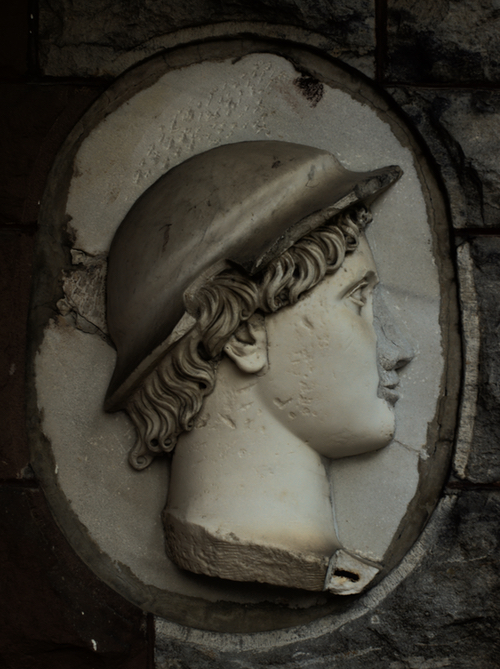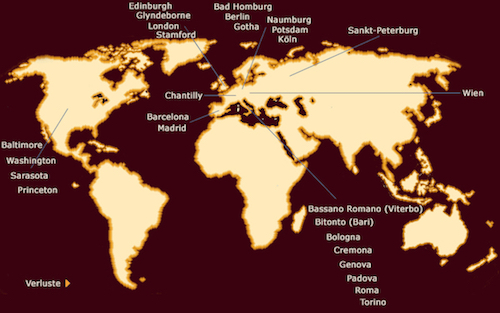Chapter 1
Introduction
The sphinx is ugly. There is no other word for it. The creature has a hound-like body, feathered wings, and a too-long neck, topped with a human head with a young face. The creature’s paws rest almost casually on the voluminous hair of a disembodied human head. The bearded face cries out with a distraught expression, eyebrows pleading, water gushing out of its gaping mouth. In contrast to this cruel scene, the sphinx’s face wears an uncannily serene expression.
Cracks and patches litter the sphinx. How many pieces does the sculpture comprise? How old are they? Where are they from? Why were they assembled together? How did the whole sculpture get here?

Figure 1: The sphinx at Sonnenberg.

Figure 2: The sarcophagus above the sphinx.
The sphinx is not alone. Looming over it, there is a decorated relief of the front of a marble casket, a sarcophagus (Figure 2). On a wall opposite the sarcophagus and sphinx, a relief with a head in profile faces them (Figure 3). On a perpendicular wall, a full-figure relief is placed just hidden from view of the sarcophagus and sphinx (Figure 4). Even though these four works of art seem ancient, they are not housed in a museum. Instead they stand in a semi-enclosed patio, the “Breakfast Bower” of Sonnenberg Gardens, an estate in remote Upstate New York.

Figure 3: The relief with a head in profile.

Figure 4: The full-figure relief.
Together and in this location, these works invite more questions than answers. Why are they here, both in Upstate New York and in this bower? Who built this mansion and brought the works here? Where do they come from? Were they always arranged together? If not, what were their previous purposes and meanings?
To answer these questions, we assembled a group—three students and one professor in a semester-long seminar at Cornell University—and dove into the world of Sonnenberg and the history of these sculptures.
We knew the sculptures once belonged to a famous collection of Greco-Roman sculptures in Italy, the Giustiniani collection. Assembled in the 17th century, the collection was soon after split up and sold piece by piece across Europe. By the 20th century the sculptures had been distributed all over the world. Scholars interested in the history of collecting have been trying to virtually reassemble the Giustiniani collection, and have tracked down items to their current locations (Figure 5). New York is conspicuously missing. We wanted to fill this void on the map, understand how the Sonnenberg sculptures first came to North America, and why the pieces interested collectors.
Initially, we thought the Sonnenberg sculptures fell out of the narrative by accident, due simply to their distance from the rest of the collection—both across the ocean and in a remote Upstate New York estate, known for its gardens, not for its sculptures. Instead we found that, in each phase of the objects’ histories, no one wanted them. The story of our discovery is chronicled in this online book.
It began with a visit to Sonnenberg Gardens to see the estate as it is today (Chapter 2). We came to realize the importance of the person behind the mansion and gardens, Mary Clark Thompson, and looked into her fascinating history and philanthropic activities (Chapter 3). We found that most of the attention, both from Mary Clark Thompson and others, was and is on the gardens (Chapter 4). The gardens do give context to the rest of the mansion, and for our interest in particular, the Breakfast Bower in which the Giustiniani sculptures reside (Chapter 5). Archival research at Sonnenberg, the Ontario County Historical Society, and the Metropolitan Museum gave us the clues to piece together the events that led Mary Clark Thompson to acquiring the sculptures and bringing some of them to her estate (Chapter 6). From this history, we gained new understandings of the sculptures, and the narratives of their “lives” (Chapter 7).
The end of the book includes a last chapter that features a “response box” for the reader (Chapter 8). For the scholarly inclined we have included an object catalogue (Appendix A), followed by suggestions for further reading (Appendix B).
Though the reader might think the sculptures which began this journey are ugly (the sphinx), for the most part not ancient (the sarcophagus excepted), and most (the Apollo and female bust aside) have historically been considered nearly worthless, both on the market and in scholarship, the Sonnenberg sculptures nevertheless provide value. They offer insights on changing attitudes to Greco-Roman art; interactions between museums, collectors, and the art market; and how people ascribe value to objects. We hope you come to appreciate them as we do.
A.H.
S.T.
Ithaca, NY
December 2017
